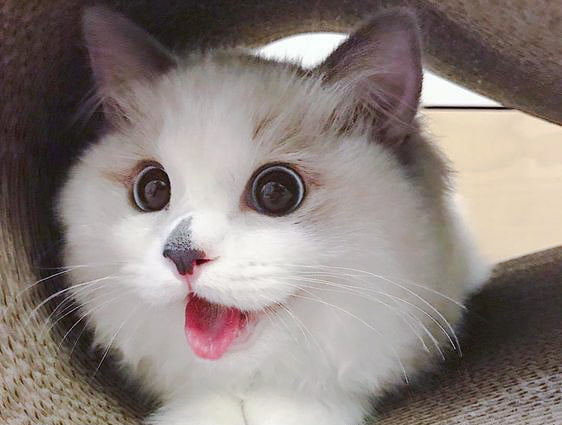It might be useful to compare the signs of contentment versus the signs of sadness in domestic cats. These are emotions at the extremes. Therefore, there should be a big apparent difference between how domestic cats behave and present to us when they feel these emotions.

RELATED: Ten Emotions That Cats Share with Us
Contentment or happiness
As is the case for humans, when there is a release of oxytocin and dopamine into the brain of a cat, they will feel content, happy or even elated. Domestic cats release oxytocin just like humans. When you stroke a cat the human brain releases oxytocin. Studies have confirmed that when humans interact with companion animals it causes the secretion of oxytocin from their bodies. The release of oxytocin is probably/possibly a key factor in creating a bond between cats and humans.
Oxytocin has the function to not only inhibit and reduce stress but to promote social behaviour. So, this feel-good peptide hormone makes cats feel good. Eating makes a cat feel good as does being petted or lying-in warm sunshine or playing with a toy and falling asleep on your lap.
Happy and contented cat show affection by allowing us to groom them and playing with us. And depending upon your personal ideas and thoughts, many people believe that cats can love their human companions and that this love is reciprocated.
To recap, a cat will express contentment by being loving with their human caregiver and seeking interaction and reassurance. In seeking interactions with their human companion, they may become more vocal and start to have long conversations with their human caregiver! The tone of their voice may indicate a more contented cat by being higher pitched.

Content cats look healthier because they are grooming themselves properly and I believe that there will be some facial differences between the content cat and the depressed cat. They will be subtle but noticeable nonetheless. This is part of an overall more relaxed posture of the content cat. And of course, a happy cat will have a good appetite.
Contentment can be elevated to the state of elation or euphoria! Elation, it seems, is translated to the “cat crazies”. This is when cats chase around madly in a burst of euphoric activity. I would also add that there can be quite a subtle difference between the cat crazies caused by being very happy and the cat crazies being caused by boredom.
But it is probably fair to say that short episodes of activity may be signs of pleasure or happiness combined with a release of pent-up emotion.
Sadness or depression
When cats are separated from their home environment with which they are very familiar, they can become sad and depressed. An example would be when they are hospitalised. Dr. Bruce Fogle tells us that the “sad hospitalised cat doesn’t show any particular fear, anger, or worry, but it doesn’t eat as usual, and it doesn’t respond to play activity from the nurses”.
Once they leave hospital and return home their sadness disappears, their appetite returns as does their activity levels.
Depression is an extreme version of sadness and it can be overwhelming to the point where it undermines the cat’s most basic survival instincts.
Drugs don’t work for child depression so why give them to cats?
Clinically depressed cats exhibit signs of complete withdrawal. They don’t want to eat or drink and seem to lose the will to live. Dr. Fogle says that he has seen clinically depressed cats overcome their depression when they have been reunited with their owners.
Depressed cats also lose the desire to be with their human companions. They may hide in corners and under furniture. They become sullen and quiet.
In general, depressed cats become less active and steep more. This is a sign of losing interest and becoming withdrawn.
I depressed cat may also stop grooming themselves causing their coat to become matted and dirty. They also may become more aggressive or perhaps are more easily provoked. Perhaps they are open to being provoked by a frustrated human caregiver because they have become so withdrawn.

Further, a depressed cat may stop using the litter box correctly and they may even start spraying to mark territory where they didn’t do it before. This may indicate a link between depression and a lack of confidence. Spraying urine is reassuring for a cat. If your cat needs reassurance this may be a part of the emotion of being depressed. It may also be an indicator as to what is the cause of the depression i.e. being bullied by a dominant cat in the home.
Please share your thoughts about signs of contentment and unhappiness in domestic cats. I really welcome the ideas of others. I am not always right. I have to take some risks when I write on topics such as this one because there are no hard and fast answers. First-hand experiences are very useful.
Below are some more pages on feline emotions.

